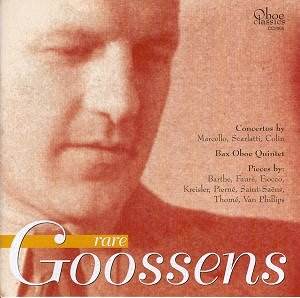By chance I heard an interview the other morning on
BBC Radio 4. The fashion for vibrato in the playing of instruments and
in singing was being challenged. Roger Norrington was one of the interviewees.
Norrington sang the praises of young orchestral players who could switch
vibrato on and off in step with the tastes of their conductor. Vibrato
was referred to as a 20th century import designed to lend expression
and emotive charge. It seems that Leon Goossens (1897-1988) was close
to the British forefront of that tendency.
Melvin Harris's excellently supportive booklet note
reminds us that Goossens’ early oboe teachers had an inexpressive vibrato-less
tone which the young player found unappealing. Revelation came when
Goossens heard the Belgian, Henri de Busscher playing at the Queen's
Hall. De Busscher played in Henry Wood's orchestra. By the time he left
for the USA, young Goossens had so imbibed his style and artistry that
Wood had no hesitation in selecting the sixteen year old Goossens to
take his place.
Goossens’ style is free. Vibrato is in the service
of an expressive emotional palette. He draws out extraordinary subtleties
and gradations of tone and dynamic. He is not afraid to play quietly
and allow other instruments their eminence as you can hear in the Bax
Quintet.
These transfers have been accomplished with clicks
nullified but with the whiskery burble of 78 ‘surface’ left intact.
Thus you can hear the 'tone' of the surfaces change from disc to disc.
I am glad this decision has been taken because the vivid impression
left is of fidelity to the artistic event that was each recording session.
If filtering or processing has been done it is unobtrusive and Goossens'
tone is left to its own eloquence.
Everything about this disc speaks complimentary volumes
about Oboe Classics’ styling and design which is clean yet beguiling.
The recording of the lugubriously melodious and chuckling
Barthe sounds it age. The Colin similarly with a Bizet-like arioso.
In this case Goossens is not really done justice to. The problem is
the forced proximity of the players to the recording horn. The Swan
is swiftly flowing while Thomé's Simple Aveu is operatic.
Fiocco's Arioso is highly romanticised. Van Phillips’ Nicolette
was inspired by a moment in time at the Café de Paris in London,
when a slim French student wended her way through the crowded room.
It is a splendid piece of light music; all stardust and Rachmaninov.
The Bax is the world premiere recording and is valuable for that. In
addition this Celtic-spirited piece displays Goossens’ artistry, his
slender tone, pliant shaping and elegant approach across a substantial
work.
The website for Oboe
Classics includes Jennie Goossens’ memoir of her father as well
as Malcolm McMillan's essay on the rewards and challenges of transferring
78s to CD.
Woodwind specialists as well as Baxians will want to
snap up this lovingly compiled and presented disc.
Rob Barnett

